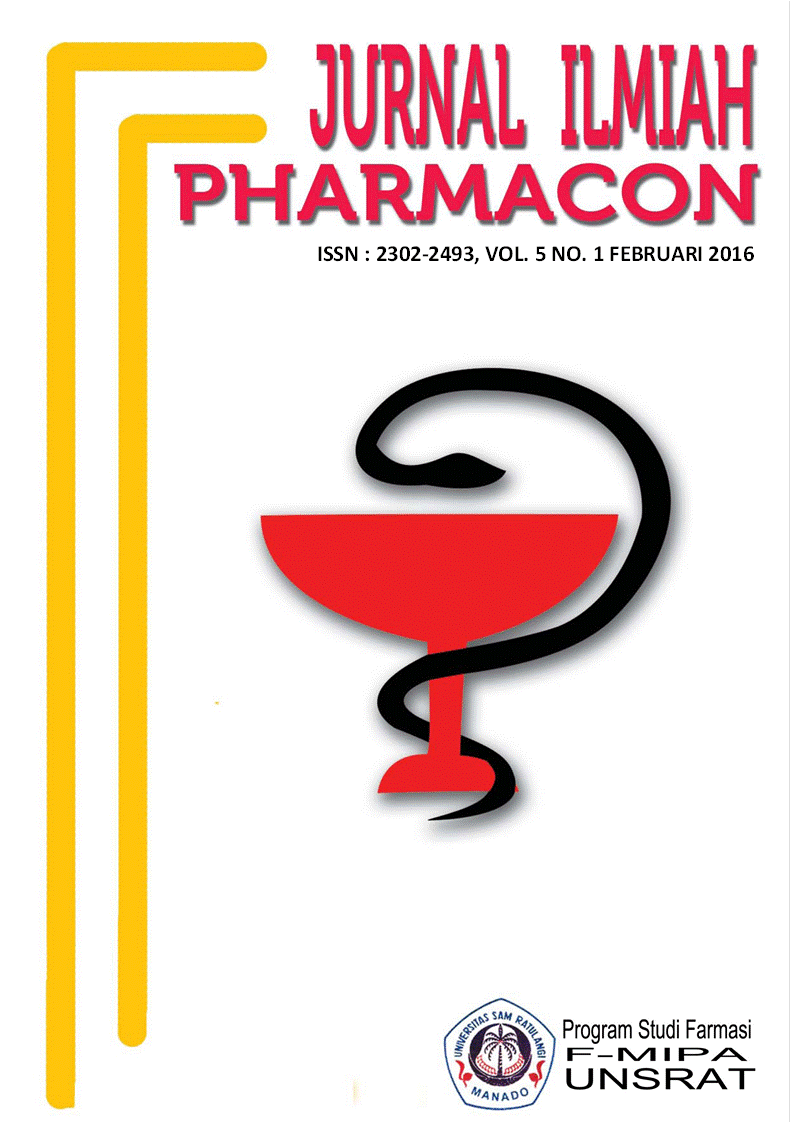UJI DAYA HAMBAT EKSTRAK DAUN DURIAN (Durio zybethinus) TERHADAP PERTUMBUHAN Candida albicans SECARA IN VITRO
DOI:
https://doi.org/10.35799/pha.5.2016.11223Abstract
UJI DAYA HAMBAT EKSTRAK DAUN DURIAN
(Durio zybethinus) TERHADAP PERTUMBUHAN
Candida albicans SECARA IN VITRO
Fryano Kandoli1), Jimmy Abijulu2), Michael Leman1)
1)Program Studi Kedokteran Gigi Fakultas Kedokteran UNSRAT
2)Jurusan Kimia FMIPA UNSRAT
ABSTRACTS
Candidiasis is fungi infection that common found in dentistry practice. The cause is Candida where seventy percent of Candida species that infecting is Candida albicans. Durian (Durio zybethinus) is original tropical fruit from Indonesia that enriched with many benefits. Durian leaf contains Saponin and Flavanoid compound that can be used as antifungal agent. The purpose of this research is to find out the effectiveness of durian leaves against Candida albicans. This research is experimental research with Post test only control group design plan. The method in this antifungal test is Kirbybauer modification method using Paper disk. The concentration of durian leaf used in this research is 100%, positive control Ketokonazole, and aquades as negative control. The Candida albicans are taken from the fungus storage in Chemistry laboratory of Mathematics and Science Faculty of Sam Ratulangi University Manado.The result of this research showed that the extract of durian leaf contains antifungal activity from the inhibition zone that formed around the paper disk contained durian leaf’s extract. This research conclude that durian leaf extract has antifungal activity in inhibiting Candida albicans’s growth as the main cause of Candidiasis.
Key words: Durian leaf (Durio zybethinus), Candida albicans, antifungi
ABSTRAK
Â
Kandidiasis merupakan infeksi jamur yang sering dijumpai dalam praktek kedokteran gigi.Penyebabnya adalah jamur Candida dimana sekitar tujuh puluh persen spesies Candida yang menginfeksi adalah Candida albicans. Durian (Durio zybethinus) merupakan tanaman buah tropis asli Indonesia yang kaya akan beragam manfaat. Daun durian memiliki senyawa Saponin dan Flavanoid yang memiliki efek antijamur. Tujuan penelitian ini untuk meneliti efektivitas ekstrak daun durian dalam menghambat pertumbuhan jamur Candida albicans. Penelitian ini merupakan penelitian eksperimental dengan rancangan penelitian Post test only control group design. Metode yang digunakan sebagai uji antijamur adalah metode modifikasi Kirbybauer menggunakan Paper Disk. Konsentrasi ekstrak daun durian yang dipakai dalam penelitian ini yaitu 100%, kontrol positif Ketoconazole, serta kontrol negatif menggunakan aquades. Jamur Candida albicans diambil dari stok jamur Laboratorium Kimia Fakultas MIPA Universitas Sam Ratulangi Manado. Hasil penelitian menunjukan bahwa ekstrak daun durian mempunyai efek anti jamur yang ditunjukan dengan terbentuknya daerah zona hambat di sekitar paper disk yang diberi ekstrak daun durian. Dari penelitian ini dapat disimpulkan bahwa ekstrak daun durian memiliki efek antijamur dalam menghambat pertumbuhan Candida albicans sebagai jamur penyebab Kandidiasis.
Â
Kata kunci: Daun durian (Durio zybethinus), Candida albicans, antijamur
Â
Downloads
Published
How to Cite
Issue
Section
License
Authors who publish with this journal agree to the following terms:
- Authors retain copyright and grant the journal right of first publication with the work simultaneously licensed under a Creative Commons Attribution-NonCommercial 4.0 International License that allows others to share the work with an acknowledgement of the work's authorship and initial publication in this journal.
- Authors are permitted and encouraged to post their work online (e.g., in institutional repositories or on their website) prior to and during the submission process, as it can lead to productive exchanges, as well as earlier and greater citation of published work (See The Effect of Open Access)










